EXECUTIVE SUMMARY
The primary purpose of the discussion is to analyse the food subscription industry, focusing on Green Chef. The company has been offering vast arrays of food options, including Keto+Paleo, Mediterranean, Fast & Fit, and Vegan. The discussion first defined the target market and consumers for the company and discussed the prospects of loyalty and profitability when focusing on categories like “butterflies” and “truefriends”. After that, the discussion was based on identifying data needed by the firm to prioritise the identified segment. The focus on customer acquisition further helped in deriving ways through which consumers can be retained to increase the profitability and acceptance of the company. Finally, the focus was on discussing the usefulness of a CRM program. In the case of Green Chef, it was found that the company needs CRM to obtain more information about consumers and their buying behaviour and intention, along with using such metrics to form personalised products and solutions for consumers. The use of social media channels and personalised communication was found to be two critical media that can help in the long-term growth and development of the company through customer retention and increased profitability.
Introduction
According to a recent analysis by Royal Mail, it is estimated that the UK subscription box business will be worth £1.8 billion by the year 2025. After seeing it is worth more than quadruple since Royal Mail’s last report on subscription boxes during the Covid-19 outbreak and an overall increase in online retail, the projection comes from the company (Wright, 2021). In 2020, subscription box purchases will total approximately £1.4 billion, and delivery firms will send just under 88 million boxes to customers across the UK (Retail Gzette, 2021).
Some 55% of subscription box customers reported buying up for subscription box services to indulge themselves during the pandemic. It was a welcome relief for many people suffering from “lockdown blues” to receive frequent delivery from subscription box providers (Sillitoe, 2020). Despite the lifting of lockdown restrictions in many parts of the UK, a new study by Barclaycard Payments shows that demand for subscriptions has risen to £395 million, a 23% increase over the previous years’ worth. According to the data, eight-three percent of subscription-selling merchants have launched an average of four subscription service items or services since the beginning of this year alone (Wright, 2021).
Retailers expect subscriptions to expand another 30% over the next year, confirming the current trend. According to Barclaycard’s retail study, British consumers pay an estimated £46 each month on subscriptions, which comes to $552 a year (Wright, 2021). Digital and subscription service spending by consumers grew each month consistently from January and July of 2020, rising by 39.4% YoY in July. Around 82% of shops said that the spike in subscriptions during the lockdown was due to customers wanting safe and convenient means to buy things (Retail Gazette, 2021). The dietary requirements of different customers can be met by Green Chef’s vegan, vegetarian, and gluten-free menu items. These are categorised as Keto+Paleo, Mediterranean, Fast & Fit, and Vegan.
They have a business plan that aims for sustainability and may grow with the rise in subscription-based food model demand. Subscription-based food models’ ad income is rising, which bodes well for their market structure. Companies have a responsibility to keep up with consumer demand while also addressing food quality and delivery issues. Among other considerations, organisations should strive to provide higher returns for customers and other stakeholders while differentiating their products.
Analysis of Customers
Loyalty Vs. Profitability
Before determining which loyal consumers are beneficial for firms, it is necessary to determine the association between loyalty and profitability. There is no need to chase or retain all loyal consumers. Loyal consumers are thought to be the best customers. It is expected that loyal consumers are more cost-effective to serve, are prepared to spend more than other customers, and promote the brand through word-of-mouth (Lin et al. 2022). Gaining the loyalty of consumers is thought to be a sure-fire strategy to increase revenues. There is a problem; however, when loyal consumers are analysed for their usefulness to the company, they tend to add value (Almohaimmeed, 2019). After assessing consumers’ profitability and projecting the length of their relationships, it is time to categorise them and treat them accordingly. Customers that are unreliable and do not generate revenue should not be considered for investment by the business. Profitable but disloyal consumers can be milked for the duration of their relationship with a company, but loyal customers should be approached with caution (Bazargan et al., 2021).
Increasing the level of communication with profitable, loyal consumers is a terrible idea since they could be turned off by an influx of phone calls and emails. The organisation should focus on figuring out how to make these customers feel good about the brand.
According to the nature of the company’s business, it may be possible to include these clients in further activities. The most valuable consumer for a company is one that has a favourable opinion of the firm and spreads the word about it (Lin et al., 2022). Loyal consumers are generally seen to be more cost-effective to serve since the cost of obtaining them is spread out across a more significant number of transactions. This, however, may not be the case. It is possible that serving repeat consumers costs more money. Customers who have been loyal to a company for a long time are valuable assets in the eyes of the firm, and as a result, they often take advantage of this to obtain better treatment and lower prices (Madhanai et al., 2019). It may be inexpensive to serve loyal consumers in some businesses, but managers must first identify those industries before they begin fostering client loyalty (Teichmann, 2021).
Consumers that have been with a company for a long time typically pay less than new customers. Regardless of whether a company is in the corporate or the consumer sector, this is true. Loyal consumers may have a better understanding of the product’s quality and better understand the product’s value compared to occasional customers. On the other hand, loyal clients believe that they are entitled to reduced costs because they frequently buy from the same company (Lin et al., 2022). It is challenging to turn profitable but ephemeral consumers into long-term ones by investing in them. These are the kinds of people you do not want to do business with. Marketing campaigns, such as mailing blitzes should incorporate special offers for additional products. It is imperative that these clients get reached as soon as possible following their most recent transaction and that a follow-up call or letter be sent to serve as a reminder. The customer should not be approached again if they do not react (Bazargan et al., 2021).
| Butterflies
Profitable but might switch to other brands within a short time |
True Friends
They drive the majority of profits and are generally a good fit between the company’s offering and consumers’ needs and demands. |
| Strangers
No profit and poor fit between what the company is offering and what consumers are demanding |
Barnacles
Low contribution to overall profits of the company results in zero contribution. |
Source: Self-Made
Regarding the focus on the most profitable set of consumers, there is no doubt that butterflies and true friends are the most profitable categories, and Green Chef should focus more on attracting true friends and keeping a balance with butterflies. A ratio may be 75:25 can help add more value and revenue to the company. In terms of mitigating the prospect of butterflies switching back to other brands, the focus should be on improving communication with them, providing them discounts and offers, and developing a sense of brand loyalty within them.
Data Needed to be Collected
It is the process of creating homogeneous groups of people with identifiable characteristics. Segmentation criteria include a person’s location, age, lifestyle, and even how they interact with your website (Vigneau, 2018). Expectations and reactions to an offering, type of material, or a required display should be the same for those in the same segment. It is possible to compromise with traditional mass marketing and please the most significant number of individuals with the same product or service. On the other hand, segmentation enables organisations to focus on the needs of each consumer (Vigneau, 2020).
There is a definite need for this, as 91% of customers prefer to purchase from companies that provide them with tailored experiences. Market segmentation is identifying and categorising your target audience based on the qualities and behaviours they exhibit. You may use this information to better target your marketing efforts in the future by determining which customer segments are the most loyal to the brand (or those who spend the most, or those who are least loyal, etc.). This will allow businesses to offer customers a better experience and retain customers (Ghvanidze et al., 2019).
If the company uses the “a priori” method or rule-based segmentation, you manually divide your audience into homogeneous subsets based on predetermined criteria. Data analysis or common sense can both be used to determine the criteria. Visits and assessments of behavioural criteria create hot data for the company (Serrano-Malebrán et al., 2021). Cold data, based on demographic parameters such as age, ethnicity, and behavioural information from purchases, is also necessary. However, a thorough examination of regional, demographic, psychographic, and psychological data is just as critical as focusing on profitable customers for Green Chef.
For a sector to be valid, it must consist of visitors who have a high added value for the organisation. Segments must also be distinct from one another to be helpful, as they are not expected to respond in the same manner to your marketing initiatives. Even while Green Chef may have more money from “tree buddies,” if they focus on earning from every transaction, the income from “butterflies” can also be beneficial. In other words, the organisation needs a clear picture of how many potential customers make up the segment, how much money they must spend, and how they shop. The company will be able to determine the division’s profitability by studying these factors. The company must be able to tap the segment’s potential through marketing activities (Slupik et al., 2021).
This means a corporation must be able to interact with its customers, whether that means providing things they have ordered via television, radio, or social media. If Green Chef wants to appeal to a younger demographic, it must have a presence on social media platforms like Instagram and Twitter. Therefore, a period of 9 months needs to be considered for evaluating consumers’ conversion. The below illustration provides some interesting insights. (Partridge, 2019).
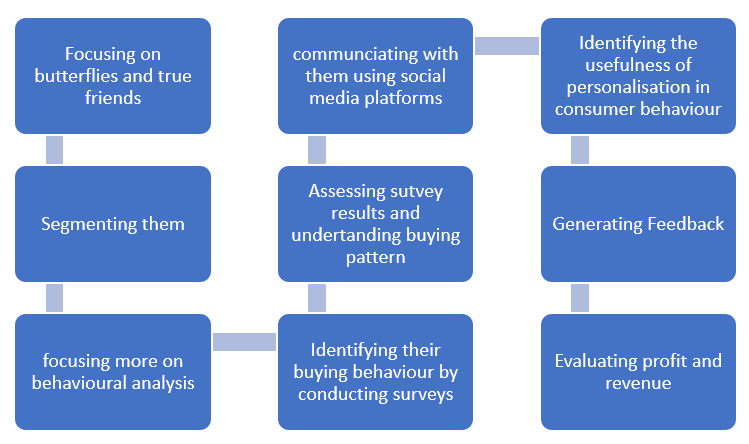
Source: Self-Made
Customer Database for Customer Acquisition
Customer relationship management (CRM) databases aggregate all a firm’s interactions with its customers and present them to the company in a single, easily customised dashboard for easy access and analysis. Green Chef has already built a CRM database using the feeds created during the sales process. When it comes to demographic variables such as age and gender, marital status, and household composition, the corporation already has much information about its customers (Du et al., 2019).
On the other hand, acquiring new customers or clients is known as customer acquisition. Professionals in customer acquisition employ a variety of strategies to entice potential clients to make a purchase. As a result of this procedure, a long-term plan for attracting new clients and increasing revenue for the company will be developed. The following illustration explains the process of customer acquisition in a detailed manner (Isson, 2019).
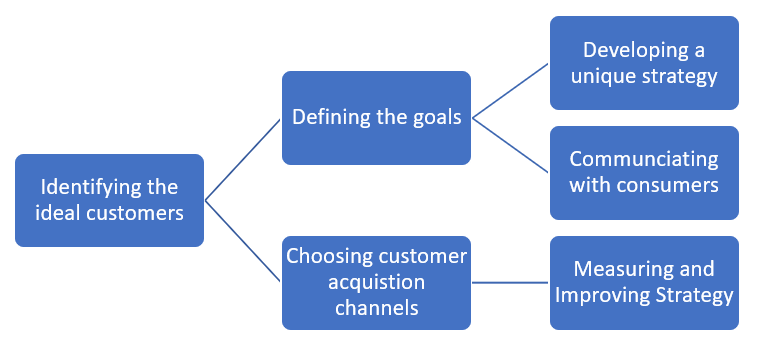
Source: Self-Made
Customer acquisition goals should consider the rate of customer attrition and existing customer growth to satisfy revenue forecasts (Saglam et al., 2021). With a new client acquisition approach, the focus should be much more on meeting the aim of £255 million in revenue by the end of 2022 for Green Chef, which produced £255 million in revenue in 2020 (Anon, 2020). The organisation must focus on several channels to get more data and information. These streams include Instagram for visually appealing posts and short videos; Facebook for live video streaming and one-on-one messaging; Facebook advertising; YouTube for longer videos; SEO for written, long-form content optimised for search engines; and paid social for short, quippy ads with appealing visuals. Regarding incentives for referrals, discounts and loyalty programmes should be at the top of the list (Stahl et al., 2012).
A lack of direct client feedback makes identifying the weak points in your customer acquisition process extremely difficult. It is necessary to make a formal request to obtain this valuable data (Isssan, 2018). These methods are good ways to communicate with your customers: questionnaires, email contact options, customer surveys, online posts, and blog entries. An offer can be advertised, feedback can be requested, and a person can be accessible to speak with. As a result of the company’s business model, Green Chef needs to invest more in maintaining clients. To keep clients for an extended period, the organisation must also increase its attention on personalisation methods.
As discussed earlier, Green Chef needs to focus more on “butterflies” and “truefriends”, which are the two highly profitable segments for the company and, when turned loyal, can help improve the revenue structure for the company (Padilla et al. 2021). Technology for managing all company contacts and interactions with current and potential customers is known as customer relationship management (CRM). Customers, service users, coworkers, and suppliers can benefit from a CRM solution since it helps you keep track of the relationship with each of these individuals throughout your relationship with them (Kim et al., 2020). According to Gartner, CRM will account for more than half of enterprise software revenue by 2021. If a company is to last, it must have a long-term plan.
Green Chef may set targets for the company’s revenue and profitability, But it can be challenging to receive accurate and up-to-date information about the project’s progress. Data from sales, customer support, promotion, and sentiment analysis must be converted into actionable business intelligence. Organizing customer and prospect data in a way that helps you develop deeper relationships and accelerate business growth is the goal of most customer management (CRM) solutions. CRM systems begin by gathering information from several sources and channels, such as a customer’s website, email, phone, and social media accounts (Lu et al., 2020).
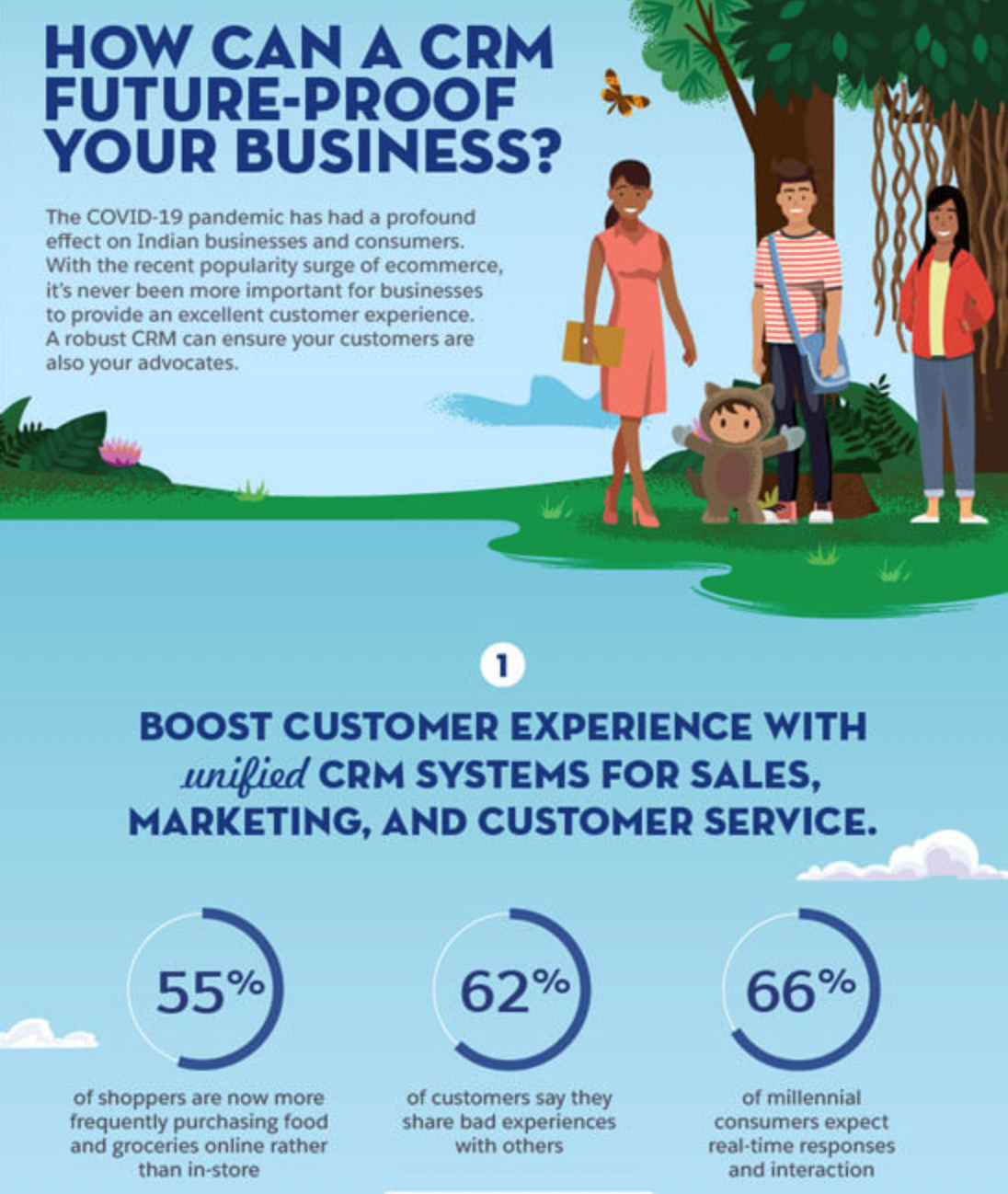
Source: Sales Force (2022)
Information about current company activities and personal choices on communications may also be automatically gathered. The system stores both types of data. The CRM tool integrates this information into a comprehensive record of individuals and enterprises (Sigala, 2018).
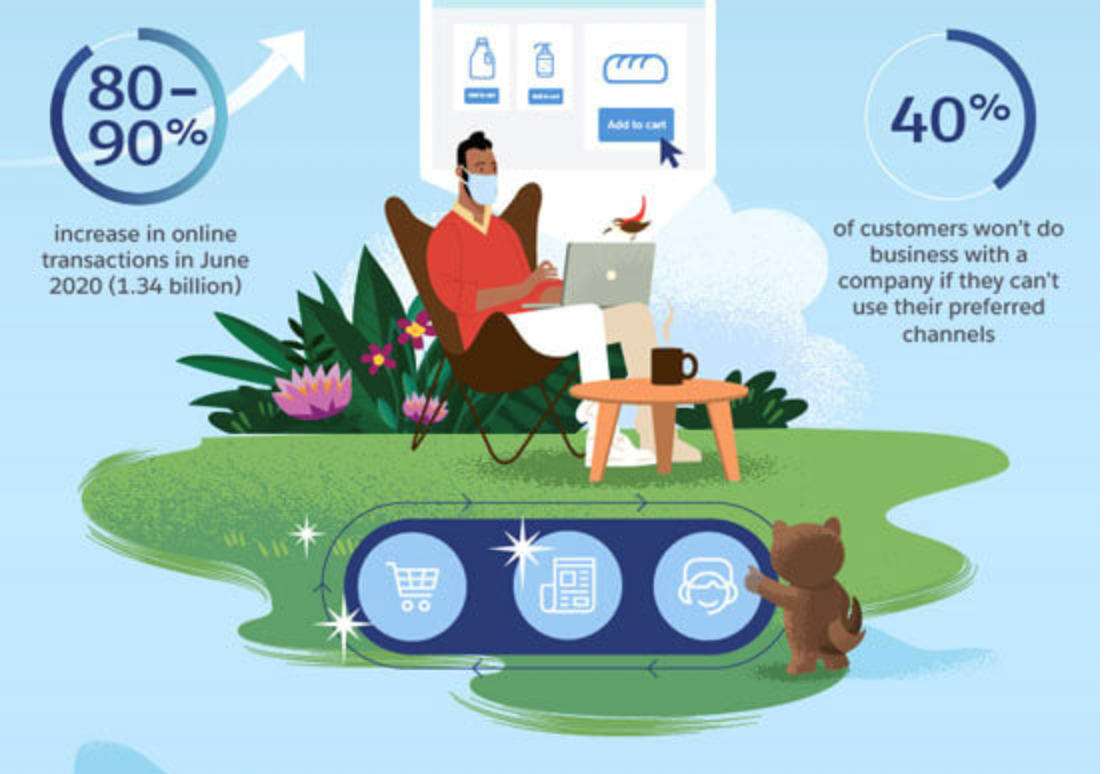
Source: Sales Force (2022)
In addition to connecting to other business tools, a CRM platform may also be used to help organisations build relationships with their customers. When it comes to customer relationship management (CRM) systems, today, they are more open and maybe integrated with organisations’ favourite business tools like document signing, accounting, billing, and surveys so that data moves both ways to provide you with an actual 360-degree perspective of your client. In addition, a new CRM generation goes even further (Gyula Laszlo, 2018). Administrative operations such as data input and lead or service case routing can be automated by the system’s built-in intelligence, freeing up your time for more worthwhile pursuits (Shin et al. 2020). As a result of these insights, firms can better understand their customers and even forecast how they feel and act. An effective CRM system that can swiftly discover and categorise new leads should be a top priority for Green Chef.
Focusing on the good leads allows sales to prioritise opportunities that will close, while marketing can discover leads that need further nurturing and prepare them to become quality leads (Denizci Guillet et al. 2019).

Source: Sales Force (2022)
Sales and marketing teams may better target their efforts and resources on the correct customers when they have access to accurate information on current and potential customers. Cross-selling and upselling possibilities become apparent as consumers’ needs are better understood, allowing businesses to gain new business from existing ones.
Customers will be more satisfied because of the company’s increased visibility. According to specific research, happy customers are more likely to return, and repeat customers spend 33% more than new customers. Green Chef’s CRM system should be able to gather data from a wide range of sources, including but not limited to its operations and those of its clients. As a result, Green Chef can better understand their consumers’ perceptions of the company and what they have to say about it. Customer relationship management systems can combine sales, marketing, and customer support to provide a holistic view of a company’s customers (Sales Force, 2022). With 62% of consumers willing to spread the word about a terrible experience, the importance of establishing a positive customer experience cannot be emphasised. 60% of millennial customers anticipate immediate responses and engagements, and 40% of all customers refuse to do business with a firm if they cannot use their chosen communication method to communicate with the company. The customer experience can be enhanced with a CRM that keeps track of all these interactions across devices and time zones (Sales Force, 2022).
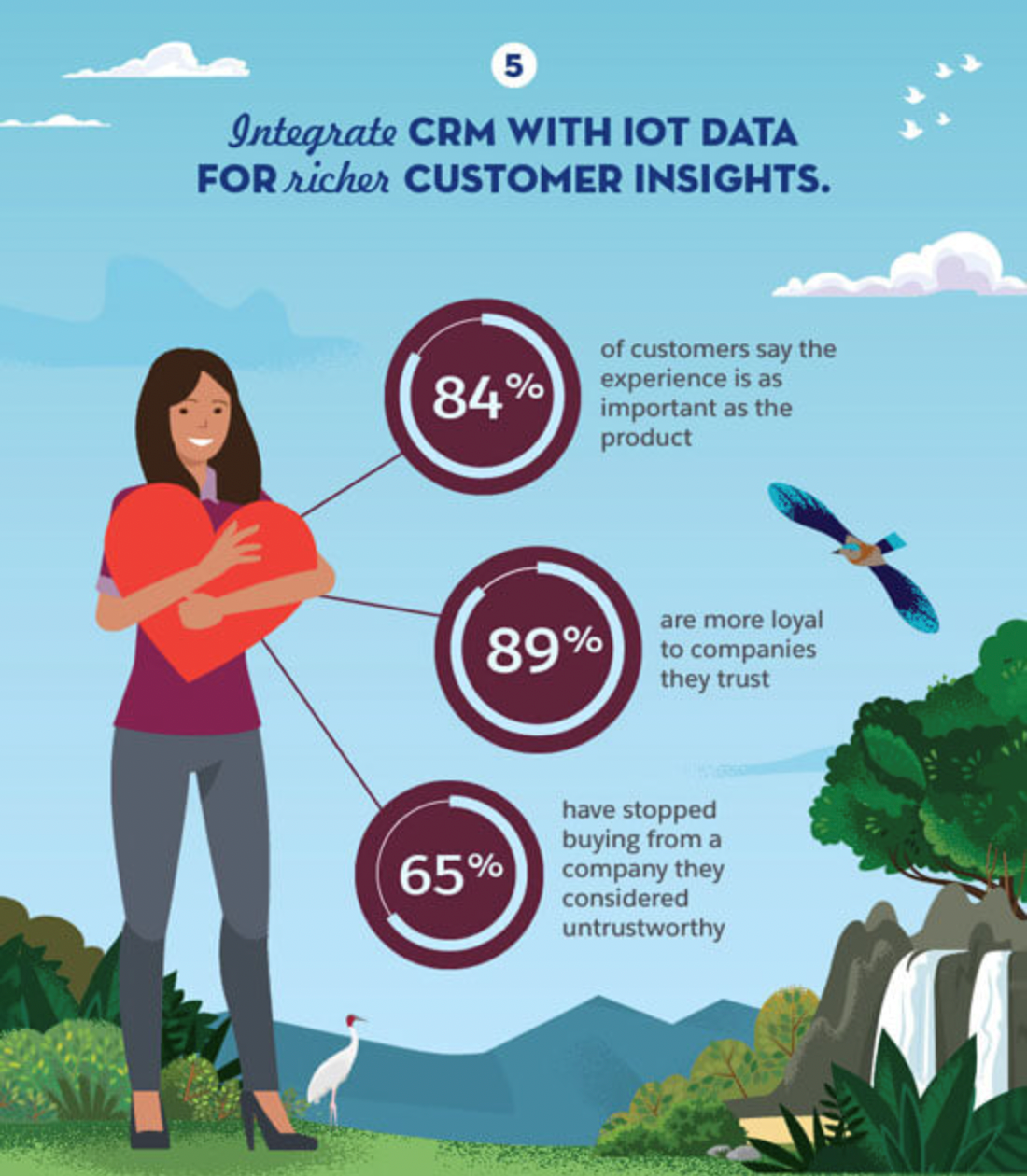
Source: Sales Force (2022)
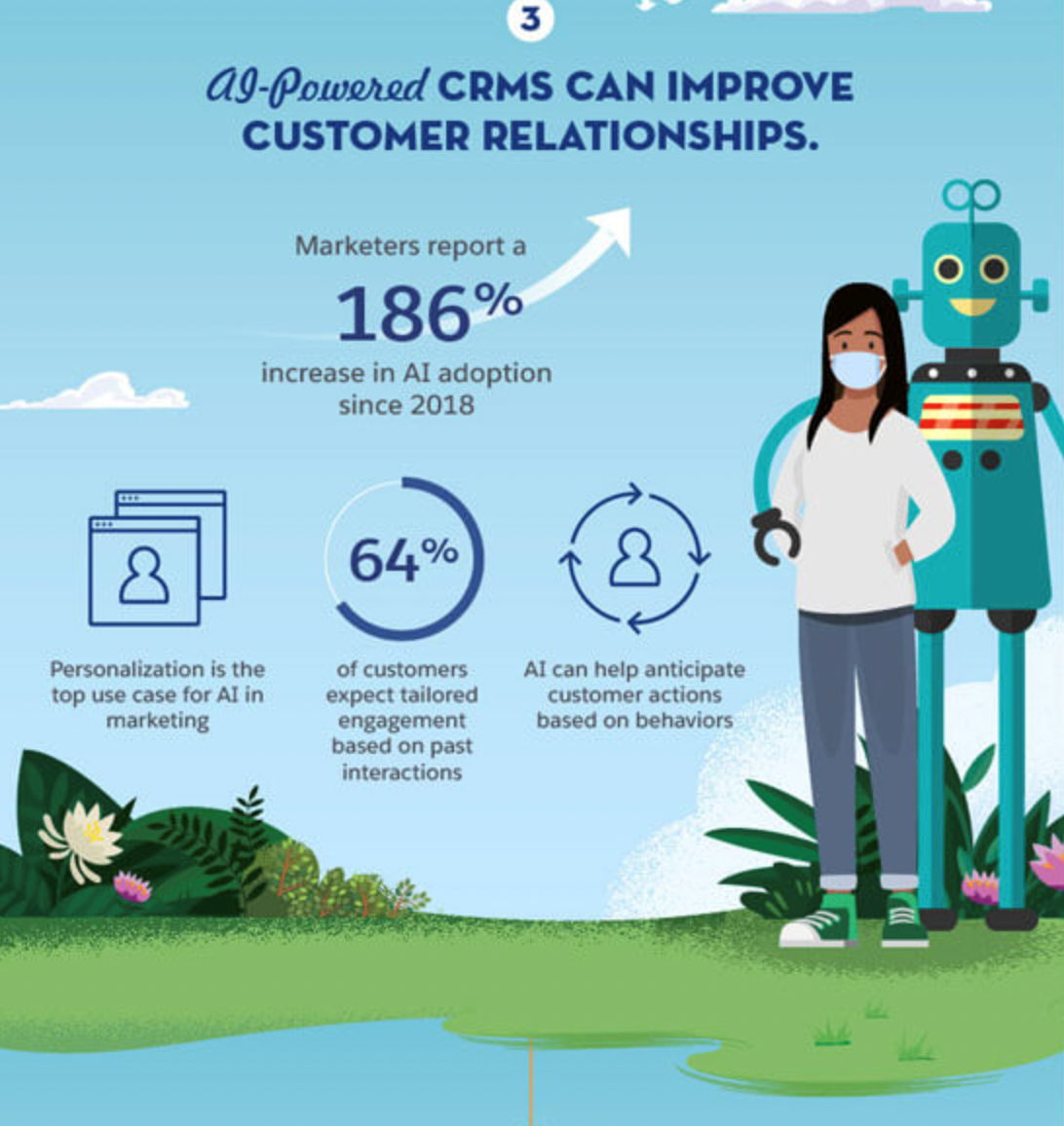
Source: Sales Force (2022)
There are several reasons to implement CRM software. Businesses, for example, must ensure that the customer defines each customer encounter to personalise the customer experience. A whopping 61% of millennials are open to sharing personal data for a more tailored shopping experience, making this generation the first to fully embrace hyper-many personalization’s advantages (Sales Force, 2022).
There are various ways to implement hyper-personalization, including customising items, offering specific products in certain areas because they are popular, and using multichannel data to personalise messaging (Pham-Singer et al., 2021). Most consumers agree that being treated as a person and not just a number is significant. Hyper-potential personalisation boosts customer satisfaction while simultaneously increasing revenue is one of the benefits of this approach (Dewnarain, 2019). Similarly, Green Chef must take advantage of modern technology. With the help of Artificial Intelligence, businesses can make better and faster decisions (AI). More than 64 per cent of customers anticipate personalised engagement based on their previous encounters, and marketing AI can collect data from these interactions to predict what messages your customers would respond best to (Sales Force, 2022).
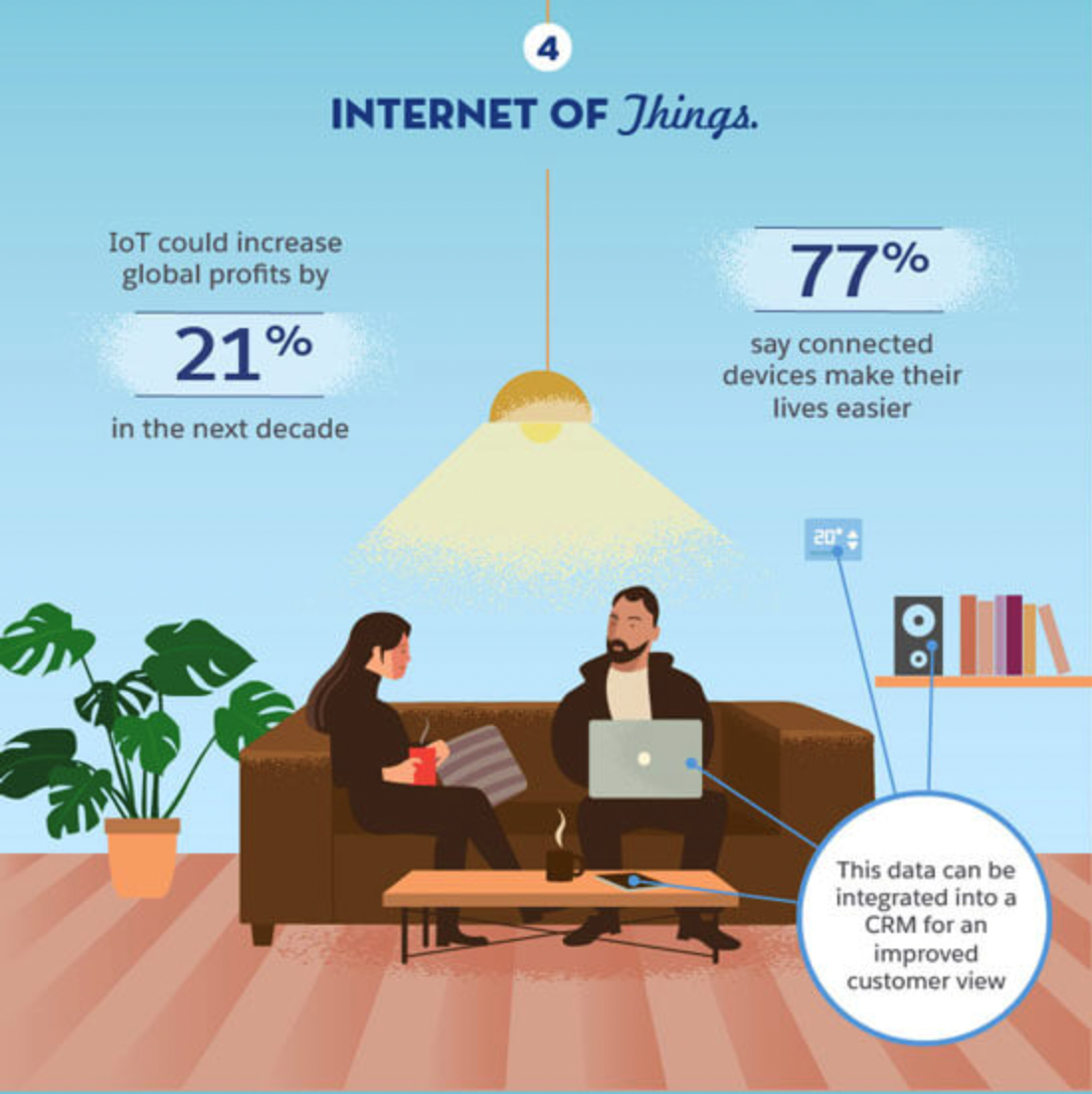
Source: Sales Force (2022)
With 71% of customers starting and completing a single purchase over various channels, AI is essential for sales to monitor clients across mediums and devices (Sales Force, 2022). Additionally, people prefer self-service channels like knowledge sources or customer portals for simple concerns or difficulties. Sixty-eight percent of customers say this. The CRM platform can get a steady stream of data from the linked devices all around us. Global corporate profits are expected to rise by 21% over the next decade because of the Internet of Things. Seventy-seven percent of people feel connected products make their lives easier (Sales Force, 2022). As a result, there is great potential for customer engagement and product development to be improved. Therefore, Green Chef could use visual social media networks like Instagram and Facebook to reach the audience and engage in personalised conversations with a broader range of potential customers and clients. All these actions will contribute to the CRM retention goal in the long run.
Conclusion
In conclusion, the company should be using the following incentives and two types of media for reaching out to multiple consumers and increasing the prospects of profitability in the long run.
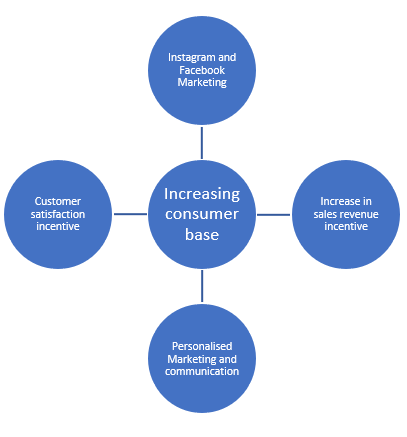
REFERENCES
Anon, 2018. Germany-based HELLO FRESH SE acquired GREEN CHEF, Denver, CO. The Food Institute report, 91(12), p.6.
Anon, 2020. Germany-based HELLO FRESH SE acquired GREEN CHEF, Denver, CO. The Food Institute report, 91(12), p.6.
Anon, 2020. Gatorade Case Study: Using Consumer Segmentation & Social Media to Drive Market Growth, Datamonitor
Anon, 2019. Green Chef Strengthens Sustainability Commitment with Launch of Plastic Offset Program. Ecology, Environment & Conservation, p.175.
Anon, 2019. Green Chef Further Expands Its Specialty Menu Offerings with Four New Meal Plans. Life Science Weekly, p.2087.
Almohaimmeed, B., 2019. Pillars of customer retention: An empirical study on the influence of customer satisfaction, loyalty, and profitability on customer retention. Serbian journal of management, 14(2), 421–435.
Bazargan, A., Karray, S. & Zolfaghari, S., 2021. Can restrictions on redemption timing boost the profitability of loyalty programs in competitive environments? Computational management science, 18(1), pp.99–124.
Denizci Guillet, B. & Shi, X., 2019. Can revenue management be integrated with customer relationship management? International journal of contemporary hospitality management, 31(2), pp.978–997.
Dewnarain, S., Ramkissoon, H. & Mavondo, F., 2019. Social customer relationship management: An integrated conceptual framework. Journal of hospitality marketing & management, 28(2), pp.172–188.
Du, H.S. et al., 2019. Achieving mobile social media popularity to enhance customer acquisition. Internet Research, 29(6), pp.1386–1409.
Gyula Laszlo, F., 2018. Customer Relationship Management Using Business Software. SEA – Practical Application of Science, VI (18), pp.291–298.
Ghvanidze, S. et al., 2019. Are Sustainable Consumers Health Conscious? A Segmentation Study of Wine Consumers. Journal of food products marketing, 25(6), pp.690–711.
Kim, Y.S. & Baker, M.A., 2020. I Earn It, But They Just Get It: Loyalty Program Customer Reactions to Unearned Preferential Treatment in the Social Servicescape. Cornell hospitality quarterly, 61(1), pp.84–97.
Lu, Q.S. & Miller, R., 2019. How Social Media Communications Combine with Customer Loyalty Management to Boost Green Retail Sales. Journal of interactive marketing, 46, pp.87–100.
Lin, C. & Bowman, D., 2022. The impact of introducing a customer loyalty program on category sales and profitability. Journal of retailing and consumer services, 64, p.102769.
Madhani, P.M., 2019. Rewards Strategy: A Key Driver of Service–Profit Chain. Compensation and benefits review, 51(4), pp.162–172.
Padilla, N. & Ascarza, E., 2021. Overcoming the Cold Start Problem of Customer Relationship Management Using a Probabilistic Machine Learning Approach. Journal of marketing research, 58(5), pp.981–1006.
Partridge, S.R., 2019. Nutritional Qualities of Commercial Meal Kit Subscription Services in Australia. Nutrients, 11(11), p.2679.
Pham-Singer, H. et al., 2021. Using a Customer Relationship Management System to Manage a Quality Improvement Intervention. American journal of medical quality, 36(4), pp.247–254.
Retail Gazette, 2021. The rise of subscription boxes in UK retail. [online] Available at https://markets.businessinsider.com/news/stocks/the-rise-of-subscription-boxes-in-uk-retail-10425858.[Accessed April, 03, 2022]
Sillitoe, R, 2020. Morrisons and Pret join UK retail’s growing subscription economy.[online] Available at https://www.computerweekly.com/feature/Morrisons-and-Pret-join-UK-retails-growing-subscription-economy. [Accessed April 03, 2022]
Sigala, M., 2018. Implementing social customer relationship management. International journal of contemporary hospitality management, 30(7), pp.2698–2726.
SalesForce. 2022. What is CRM? [online] Available at https://www.salesforce.com/in/crm/what-is-crm/. [accessed April 03, 2022]
Shin, M. et al., 2020. Enhancing customer-brand relationships by leveraging loyalty program experiences that foster customer-brand identification. International journal of contemporary hospitality management, 32(12), pp.3991–401
Sağlam, M. & Montaser, S.E., 2021. The effect of customer relationship marketing on customer retention and customer acquisition. International journal of commerce and finance, 7(1), pp.191–201.
Stahl, F. et al., 2012. The Impact of Brand Equity on Customer Acquisition, Retention, and Profit Margin. Journal of Marketing, 76(4), pp.44–63.
Serrano-Malebrán, J. & Arenas-Gaitán, J., 2021. When does personalization work on social media? A posteriori segmentation of consumers. Multimedia tools and applications, 80(30), pp.36509–36528.
Słupik, S., Kos-Łabędowicz, J. & Trzęsiok, J., 2021. An Innovative Approach to Energy Consumer Segmentation—A Behavioural Perspective. The Case of the Eco-Bot Project. Energies (Basel), 14(12), p.3556.
Teichmann, K., 2021. Loyal customers’ tipping points of spending for services: a reciprocity perspective. European journal of marketing, 55(13), pp.202–229.
Vigneau, E., 2018. Segmentation of a panel of consumers with missing data. Food quality and preference, 67, pp.10–17.
Vigneau, E. et al., 2022. Combining hedonic information and CATA description for consumer segmentation. Food quality and preference, 95, p.104358.
Wright, G, 2021. The rise and rise of subscription boxes in UK retail. online] Available at https://www.retailgazette.co.uk/blog/2021/08/the-rise-and-rise-of-subscription-boxes-in-uk-retail/. [Accessed April 03, 2022]
 write
write